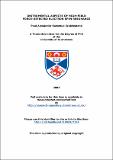Files in this item
Instrumental aspects of high-field force-detected electron spin resonance
Item metadata
| dc.contributor.advisor | Smith, Graham Murray | |
| dc.contributor.author | Cruickshank, Paul Alexander Sawchuk | |
| dc.coverage.spatial | xi, 175 p. | en_US |
| dc.date.accessioned | 2015-08-04T10:35:07Z | |
| dc.date.available | 2015-08-04T10:35:07Z | |
| dc.date.issued | 2003 | |
| dc.identifier | uk.bl.ethos.586906 | |
| dc.identifier.uri | https://hdl.handle.net/10023/7114 | |
| dc.description.abstract | Magnetic resonance force microscopy (MRFM) is a new measurement technique combining scanning probe microscopy (SPM) and MR spectroscopy, offering the potential of high resolution chemical specific imaging. MRFM is based on the principle of force detection of magnetic resonance (FDMR) in which the magnetisation of a sample in a magnetic field is coupled to an atomic force microscopy cantilever via a field gradient. Magnetic resonance is used to modulate the sample magnetisation at the cantilever resonant frequency and the resulting oscillating force on the cantilever leads to oscillations which may be detected optically. The high sensitivity of force detection offers the potential for single electron spin sensitivity. This thesis describes instrumental aspects of ESR based FDMR experiments and presents the first results at high fields (3.3T). High fields are advantageous for sensitivity and spectral resolution. However, they pose significant technical challenges. FDMR measurements on the organic conductor (fluoranthene)2PF6 were carried out in experiments based around an existing quasi-optical high field ESR spectrometer. Further measurements on (FA)2PF6 and DPPH are presented together with progress towards the construction of a high field MRFM system, based on a commercial SPM instrument. Experiments were performed with both magnet-on-cantilever and sample-on-cantilever configurations with the former the favoured method for potential imaging applications. Signal detection uses a novel fibre-optic interferometer. Cantilever magnets of low conductivity ferrite appear to be more promising for high Q measurements than the metallic magnets favoured by most other groups. Experiment sensitivities are estimated at around 4.4 x 10⁸ polarised electron spins, comparable to conventional commercial ESR spectrometers. Experimental consistency was difficult, especially regarding the positioning of probe and sample, an area in which refinement is essential for repeatable and sensitive experiments. The potential for imaging is attractive and the prospect of single spin detection is discussed. | en_US |
| dc.language.iso | en | en_US |
| dc.publisher | University of St Andrews | |
| dc.subject.lcc | QC762.6M34C8 | |
| dc.subject.lcsh | Magnetic resonance force microscopy--Instruments | en_US |
| dc.subject.lcsh | Electron paramagnetic resonance | en_US |
| dc.title | Instrumental aspects of high-field force-detected electron spin resonance | en_US |
| dc.type | Thesis | en_US |
| dc.type.qualificationlevel | Doctoral | en_US |
| dc.type.qualificationname | PhD Doctor of Philosophy | en_US |
| dc.publisher.institution | The University of St Andrews | en_US |
This item appears in the following Collection(s)
Items in the St Andrews Research Repository are protected by copyright, with all rights reserved, unless otherwise indicated.

